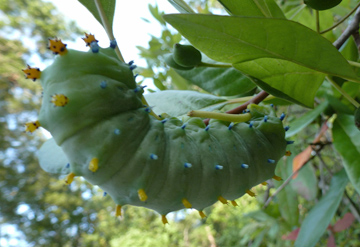


Yesterday, I put small caterpillars on newly emerging buds on a couple of orchids. Never before I have done such a thing, nor have caterpillars ever been recommended in this column as a cure for anything. So why was it done? It is a long story!
Almost two months ago, aphids arrived in my greenhouse on a houseplant
stashed in the greenhouse. You can imagine my horror because I had never
had aphids before and they quickly spread onto Paphiopetalum buds. As
treatment with light oil began it was apparent that large red ants were
also present on the orchid buds, so I assumed they were transporting the
aphids around. This particular type of ant is usually associated with
rotting wood here in Florida, so I assumed they were “up to no good”.
They were sprayed too, and that should have ended the story. Each day
when I examined the plants that previously had hosted the aphids, the
ants were present, but not the aphids. In fact, they seemed to be
picking up the dead aphids and hauling them off.
In the tropics, every orchid collector knows that many orchids are
protected by vicious ants that live on and in epiphytic orchids. Some
like the Mormyrica (previously the hollow bulbed Schomburgkia), even
provide housing. Northern Florida is almost tropical! Could these new
residents of my greenhouse be helpful? That should explain the
caterpillar experiment.
There have been many attempts to use natural predators to help with
insect control in greenhouses, but none have proven successful.
Releasing insect predators into the greenhouse typically results in the
insects predators quickly looking for a way out. After a few
unsuccessful trys, my experimentation ended with that approach and like
most others, I resorted to pesticides.
Many very effective and toxic chemicals are no longer available, so the
control of pests has become harder. Fortunately, there are some new
chemical approaches that attack the insect hormonal system and which
work very well. Of course, these products are much more expensive, but
well worth the money, since spraying is greatly reduced and the toxicity
in growing areas reduced. This also allows some of the other natural
predators to live among your orchids.
Here in Northeast Florida there are three species of lizard, one a nocturnal gecko and several species of tree frogs that also come out at night. Do they control all my pest problems? Unfortunately, the answer is no, but they clearly help. No natural control can eliminate all pests because that would involve eliminating the food source for pest predators. Will the same fate befall my new found ants? As I observed the ants it was clear that they were using the tiny drops of sugary fluid that exudes from certain tissues, especially on the flowering parts. The green anole lizards also use this resource, which allows them to survive in winter when insect prey numbers are small.
So what happened to the caterpillars I put on my orchids? The ants
quickly took care of these pests for me. So are they good ants or bad?
The jury is still out, but so far they have done no harm, short of a
nasty sting when they are in an orchid pot that is being repotted. More
on this as the experiment continues.